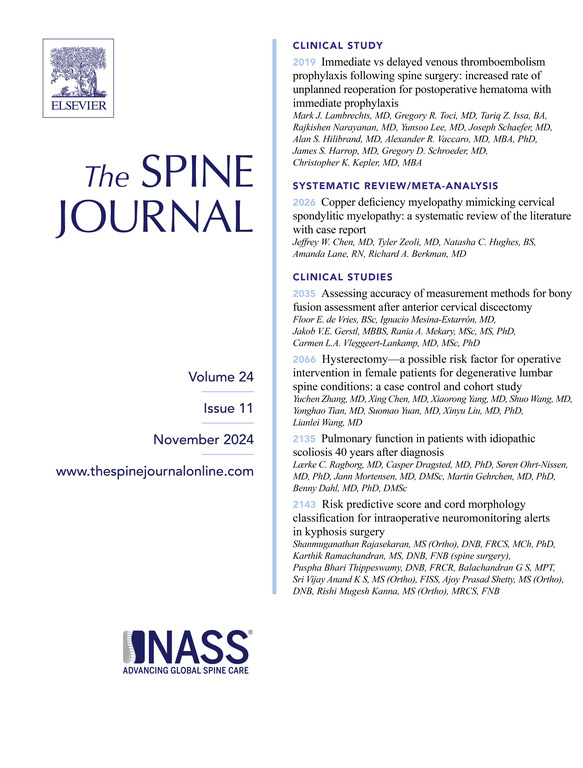Long-term outcomes of anterior cervical dynamic implants: motion-sparing or a delayed fusion?
IF 4.9
1区 医学
Q1 CLINICAL NEUROLOGY
引用次数: 0
Abstract
Background Context
Use of an anterior cervical dynamic implant (ACDI) is generally considered a nonfusion technique for treating cervical degenerative disorders. However, there is limited research focused on evaluating the long-term clinical and radiographic outcomes of ACDI.
Purpose
To analyze the long-term clinical and radiographic outcomes of ACDI in the treatment of degenerative cervical disorders.
Study Design
A retrospective cohort study.
Patients Sample
Patients with degenerative cervical disorders who underwent anterior cervical discectomy and dynamic cervical implant (DCI) implantation between May 2012 and August 2020 at our institution were included in this study.
Outcome Measures
Clinical outcomes were assessed using the modified Japanese Orthopedic Association (mJOA), visual analog scale (VAS) scores and patient reported satisfaction rate. Imaging assessment parameters included intervertebral height (IH), intervertebral disc height (IDH), C2-7 range of motion (ROM), segmental ROM, the degree of DCI subsidence and anterior migration, heterotopic ossification (HO) as well as adjacent segment degeneration (ASD).
Methods
JOA and VAS scores were obtained through questionnaire. The patient reported satisfaction was rated as very satisfied, satisfied, less satisfied and dissatisfied at the final follow-up. The position of the implants, IDH and IH were evaluated on lateral radiographs. ROM at C2-7, ROM at operated level were measured on dynamic radiographs. Cervical 3-dimensional computer tomography (CT) and magnetic resonance image (MRI) images were used to assess the presence of HO and ASD. The clinical and radiologic variables between the preoperative period and different follow-up time point were statistically analyzed by unpaired t-tests or chi-square tests. Statistical significance was defined as p<.05.
Results
A total of 92 patients (51 males and 41 females) were included in this study. Among them, there were 36 cases of cervical spondylotic myelopathy, 26 cases of cervical radiculopathy, and 30 cases of myeloradiculopathy. The mean age was 55.1±12.6 years. The number of operated levels was single level in 57 patients, 2 levels in 31 patients, and 3 levels in 4 patients. The average follow-up period was 81.3 months (range: 35-135 months). The mean JOA scores showed a gradual increase at 1 month, 1 year, and the final follow-up (12.0±0.7,13.5±0.8, and14.4±1.1 respectively) compared to the preoperative score (9.1±0.9, p<.01). VAS scores significantly decreased at 1 month, 1 year, and the final follow-up (4.1±0.7, 2.3±0.9, and 2.0±0.8 respectively) compared to the preoperative score (7.2±l .2, p<.01). At the final follow-up, the patient reported satisfaction was rated as very satisfied, satisfied, less satisfied and dissatisfied (79%, 10%, 10%, 1% respectively). Revision surgery was not required for any of the patients during the follow-up period, either due to instrumentation failure or adjacent segmental diseases. In the radiographic assessment, there was a notable increase in IH and IDH after surgery compared to preoperative values (33.0±4.0 mm vs 30.7±3.0 mm, p<.01 and 6.7±2.4 mm vs 4.6±0.9 mm, p<.01 respectively), which gradually decreased at 1 year and the final follow-up (IH: 32.1±2.5 vs 30.9±3.5 p=.024; IDH: 5.3±1.5 mm vs 4.3±0.6 mm, p=.043 respectively). At the 1-month postoperative follow-up, the segmental ROM exhibited a decrease compared with preoperative values (6.2±1.8° vs 7.5±2.0° p=.044), followed by an increase at the 1-year follow-up (6.2±1.8° vs 6.4±1.5° p=.078), but ultimately decreased at the final follow-up (6.4±1.5° vs 2.9±0.6°, p<.01). HO was observed in approximately 81.5% of cases (75/92), while a great proportion (41.3%) of patients experienced varying degrees of prosthesis subsidence and anterior migration during the follow-up.
Conclusions
At the long-term follow-up, a high incidence of HO, along with varying degrees of subsidence and migration of the prosthesis, were observed in most patients. As the motion preservation capability of the ACDI gradually diminishes, delayed intervertebral autofusion becomes a more likely outcome compared to motion sparing.
颈椎前路动态植入物的长期疗效:保留运动还是延迟融合?
背景情况:使用颈椎前路动态植入物(ACDI)通常被认为是治疗颈椎退行性疾病的非融合技术。目的:分析 ACDI 治疗颈椎退行性病变的长期临床和影像学结果:回顾性队列研究:2012年5月至202年8月期间在我院接受前路颈椎椎间盘切除术和动态颈椎假体(DCI)植入术的退行性颈椎病患者:临床结果采用改良日本骨科协会(mJOA)、视觉模拟量表(VAS)评分和患者报告满意率进行评估。影像学评估参数包括椎间高度(IH)、椎间盘高度(IDH)、C2-7活动范围(ROM)、节段活动范围、DCI下沉和前移程度、异位骨化(HO)以及邻近节段退变(ASD):方法:通过问卷调查获得 JOA 和 VAS 评分。方法:通过问卷调查获得 JOA 和 VAS 评分,最后随访时患者的满意度分为非常满意、满意、不太满意和不满意。通过侧位X光片评估植入物、IDH和IH的位置。在动态X光片上测量了C2-7的ROM和手术水平的ROM。颈椎三维计算机断层扫描(CT)和磁共振成像(MRI)图像用于评估是否存在HO和ASD。术前和不同随访时间点之间的临床和放射学变量采用非配对 t 检验或卡方检验进行统计分析。统计显著性定义为 p结果:本研究共纳入 92 例患者(男 51 例,女 41 例)。其中,颈椎病患者 36 例,颈椎病患者 26 例,脊髓病患者 30 例。平均年龄为(55.1±12.6)岁。57例患者的手术层次为单层,31例患者为两层,4例患者为三层。平均随访时间为 81.3 个月(范围:35-135 个月)。与术前评分(9.1±0.9,p)相比,术后一个月、一年和最后随访的平均 JOA 评分(分别为 12.0±0.7、13.5±0.8 和 14.4±1.1)呈逐渐上升趋势:在长期随访中,大多数患者都观察到了高发生率的 HO 以及不同程度的假体下沉和移位。随着 ACDI 运动保护能力的逐渐减弱,与运动保护相比,延迟性椎间自融合更有可能成为一种结果。
本文章由计算机程序翻译,如有差异,请以英文原文为准。
求助全文
约1分钟内获得全文
求助全文
来源期刊

Spine Journal
医学-临床神经学
CiteScore
8.20
自引率
6.70%
发文量
680
审稿时长
13.1 weeks
期刊介绍:
The Spine Journal, the official journal of the North American Spine Society, is an international and multidisciplinary journal that publishes original, peer-reviewed articles on research and treatment related to the spine and spine care, including basic science and clinical investigations. It is a condition of publication that manuscripts submitted to The Spine Journal have not been published, and will not be simultaneously submitted or published elsewhere. The Spine Journal also publishes major reviews of specific topics by acknowledged authorities, technical notes, teaching editorials, and other special features, Letters to the Editor-in-Chief are encouraged.
 求助内容:
求助内容: 应助结果提醒方式:
应助结果提醒方式:


